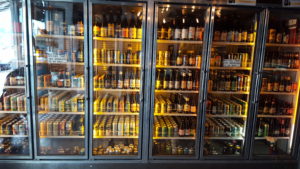
Alphabet City Beer Co. boasts a wide range of craft beers on draft and in the cooler. None of the beer sold here has been acquired by a larger company. Photo: Emily Churchill.
By Emily Churchill
The low-hanging light fixtures of Alphabet City Beer Co. dimly fill the cozy-industrial space with a soft amber glow, highlighting the outlines of the bar and its metallic stools. The lower Manhattan bar is half full, mostly with millennials and Gen. X’ers chatting away in groups. A handful of young couples with children lounges on the low leather couches. Three bartenders keep the taps busy, pouring beer into rinsed glasses while they chat with their patrons.
“What’s a cream ale?” one woman asks, pointing to the bookmark-shaped label attached to a tap handle.
“It’s like a cross between a lager and an ale,” the bartender says. Cream ales are brewed as ales, with a certain type of “top fermenting” yeast, but are sometimes finished with a “bottom fermenting” lager yeast.
Alphabet City Beer Co. pours craft beers, not high-volume commercial beers like Bud Light, Sam Adams or Yuengling. Interest in craft beers began slowly in the ‘80s and early ‘90s, dipped through the mid and late ‘90s, came back after 2000 and has been rising ever since. The draft list here is filled with obscure breweries like Off Color from Chicago, and types of beers ranging from goses (an ancient German style that mixes sour and salty flavors) to imperial stouts.
The boom carries the threat of oversaturation — and has attracted the interest of macro-breweries like Anheuser-Busch and Heineken, which are acquiring craft breweries at an ever-increasing rate. This leads to a dilemma for both brewers and consumers: is acquisition a way to protect craft beer in an exploding marketplace, or are these acquisitions compromising the micro-brew?
“It’s hard to say what’s good and what’s bad in this case,” says Zach Mack, owner of Alphabet City Beer Co. “Craft is big money. There has been a drop in beer drinking overall, but the money going up is in craft.”
The National Brewers Association has statistics to back this up, showing that in 2016, U.S. beer sales were flat, while craft beer rose 6.2 percent and exported craft beer rose 4.4 percent — which means that sales of big commercial brands actually declined.
Nationwide, the Brewers Association counted 4,225 craft breweries in 2015, up from 2,401 in 2012. The New York State Brewers Association released a comprehensive map of craft breweries throughout New York State last month. The breweries number 326, up from 120 in 2013. Paul Leone, who became the association’s executive director in 2013, estimates that in the 1990s there were approximately 38 breweries in the state. The group predicts that before the end of the year, the state will hit pre-Prohibition numbers, when there were 350 breweries.
Today, the New York State Brewers Association says that the craft beer industry has a $4 billion impact on the state, including full-time jobs, tourism revenue, state and local taxes paid, revenue from brewpubs and bottle manufacturers. This level impact the industry has on the state is ranked fourth in the nation.
According to Leone, the history of modern beer started before Prohibition, which he describes as the “real heyday of beer in the U.S.” Companies that reopened after Prohibition were swallowed up by large breweries, leading to a near monopoly — only about 30 breweries nationwide in the 1970s.
This changed in 1978 under President Jimmy Carter, who made home brewing legal. Suddenly, family-run craft breweries were sprouting up everywhere. Breweries such as Brooklyn Brewery and Sierra Nevada opened during this period. But a lot of the beer wasn’t well made, according to Leone, and customers weren’t ready for the craft scene. The market dipped until 2000.
Alphabet City’s Mack says that companies like Anheuser-Busch are picking strategically when choosing what craft brands to buy – choosing well-performing, popular regional breweries, which to him betrays their concern about the competition.
Brian Bartusch, founder of Beervana, the first company to import American craft beer into Thailand, agrees with this analysis, saying that larger companies hope to capitalize on craft’s momentum while they can.
“These companies missed the boat and now are trying to jump on the bandwagon late,” Bartusch says. “They have the money, so now they’re saying, ‘Better late than never’.”
To date, the most expensive acquisition was California’s Ballast Point, acquired by Constellation Brands in 2015 for $1 billion. Anheuser-Busch has been rapidly acquiring breweries, picking up nine since 2011, including Illinois’ Goose Island and Virginia’s Devil’s Backbone. In 2014, they acquired New York’s Blue Point Brewing, which Leone says is the only New York craft brewery that has been acquired. The purchase amount is not publicly available.
The relationship between the acquiring company and smaller company can vary widely. Bartusch says he has seen cases where a large company acquires a brewery and says they will be fully hands-off, but within a year or so, the original team has left and the recipes have changed. But he has also seen acquisitions that lead to better beer, because the parent brewery has better ingredients and brew masters.
As a beer seller, Mack doesn’t think that customers care who owns the beer they’re drinking, but the issue is more complicated for the brewers. “A lot of brewers would say that they would never sell out,” Mack says. “But then, if you have a one billion dollar check in your face…”
Trevor Jankowski, former regional manager of Lagunitas and the self-described “true craft beer guy at the forefront of the revolution,” sees acquisition as a distribution opportunity. Not only does the brewery get paid, but their beer is seen in more places.
“A lot of places don’t have the resources to distribute,” he says.
Mack holds the valuable space on the shelves, and in the twelve tap lines, for the independent breweries.
“I give the little guys the space,” he says. “You don’t need the space if you have the advertising might of Anheuser-Busch behind you.”
Customers like Tracy Hunter, 27, appreciate this. A New Jersey resident and craft beer fan, she has visited Alphabet City several times during her trips into the city with her husband. She says she loves the unique selection of beer and the bartenders’ extensive knowledge — and she likes to support smaller businesses.
“I can’t help but be in awe of people that have the energy, drive and creative mind to come up with different needs to show the world,” she says.
She says that though there is a time and a place for “a Corona Light with a lime in it,” she appreciates the creativity in the craft industry, as well as the fact that “craft beer has so much room for growth.”
She says that though she wants to support a small brewery’s chance to make “a pretty penny” in a buy-out, she can’t help but feel sad.
“The quality of anything is usually so much better when it is done in a small amount…” she says. “Yes, big beer companies like Budweiser have done amazing things, and yes, they did start as a small brewery in someone’s basement, I’m sure. But I can’t help but root for the smaller companies.”
Tags: acquitions, alphabet city, anheuser-busch, brewers association, craft beer, heineken
Your Comments